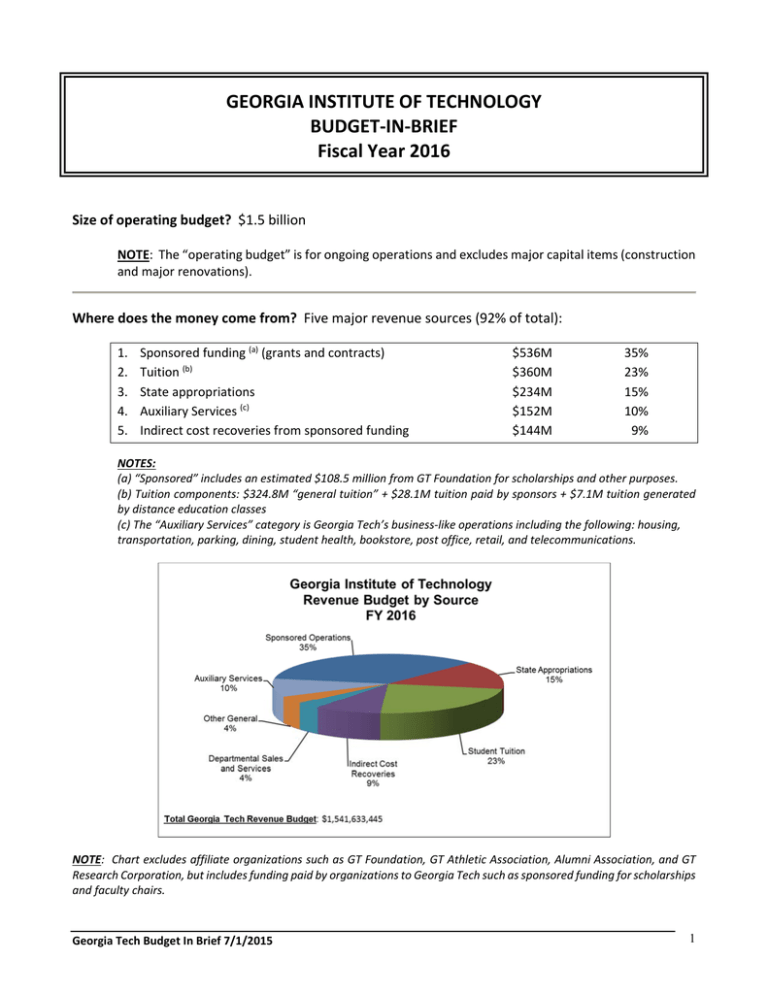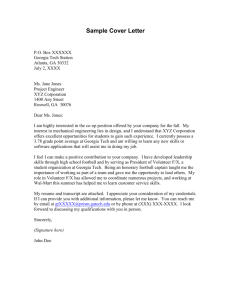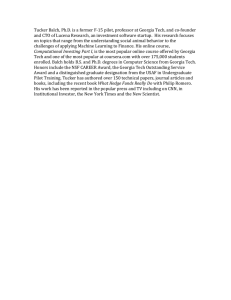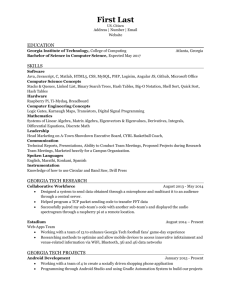georgia institute of technology budget-in-brief
advertisement

GEORGIA INSTITUTE OF TECHNOLOGY BUDGET‐IN‐BRIEF Fiscal Year 2016 Size of operating budget? $1.5 billion NOTE: The “operating budget” is for ongoing operations and excludes major capital items (construction and major renovations). Where does the money come from? Five major revenue sources (92% of total): 1. 2. 3. 4. 5. Sponsored funding (a) (grants and contracts) Tuition (b) State appropriations Auxiliary Services (c) Indirect cost recoveries from sponsored funding $536M $360M $234M $152M $144M 35% 23% 15% 10% 9% NOTES: (a) “Sponsored” includes an estimated $108.5 million from GT Foundation for scholarships and other purposes. (b) Tuition components: $324.8M “general tuition” + $28.1M tuition paid by sponsors + $7.1M tuition generated by distance education classes (c) The “Auxiliary Services” category is Georgia Tech’s business‐like operations including the following: housing, transportation, parking, dining, student health, bookstore, post office, retail, and telecommunications. NOTE: Chart excludes affiliate organizations such as GT Foundation, GT Athletic Association, Alumni Association, and GT Research Corporation, but includes funding paid by organizations to Georgia Tech such as sponsored funding for scholarships and faculty chairs. Georgia Tech Budget In Brief 7/1/2015 1 Where does the money go? Four main uses by program category (83% of total): Research Instruction Operation and maintenance of plant (including utilities & leases) Auxiliary Services $697M $288M $156M $126M 46% 19% 10% 8% NOTE: The revenue budget exceeds the expenditure budget because the business‐like operations, Auxiliary Services, are required to develop capital reserves for facility renovations and equipment replacement. How is Georgia Tech’s funding determined each year? State Allocations: Most state funding for higher education appropriated by the General Assembly to the University System of Georgia (USG) is established via a funding formula driven principally by student enrollment, considered by type of student – graduate, undergraduate, and the course of study. The Board of Regents of the university system (BOR) has proposed a change to a performance‐based formula, which would consider such success measures as student retention and graduation rates. However, this has not yet been approved for implementation. The Governor submits a proposed budget to the Legislature, in which he includes formula and other funding for the USG. He may or may not recommend full funding of the formula, and the Legislature considers his recommendations as they review the state budget proposal. The General Assembly approves state funding via the Annual Appropriations Act. These funds are principally intended to cover a portion of state institutions’ instructional costs for Georgia residents, with the balance coming from tuition and other sources. The Legislature approves funding for the entire USG, and the BOR then allocates funding to individual institutions. Through Fiscal 2016 the funding formula works as follows: Number of faculty required by enrollment mix (undergraduate and graduate students and course of study) Multiplied times: an assumed salary rate for faculty Georgia Tech Budget In Brief 7/1/2015 2 Plus instructional support and operating expenses Plus fringe benefits, other support costs, and facilities costs based on square footage Plus miscellaneous other costs, including a technology factor Equals the total funding formula requirement Minus student tuition and fees and other adjustments Equals state funding requirement to be provided by Legislature After the Legislature approves funding for the system via the Annual Appropriations Act, the Governor may veto individual line items. Upon completion of the final Appropriations Act, usually in late March or early April, the Board of Regents (BOR) determines the allocations to USG schools. The BOR generally approves allocations at its April meeting. Besides the formula funding, the Legislature earmarks funds for specific programs, such as funding for the Georgia Tech Research Institute (GTRI) and the Enterprise Innovation Institute (EI2). As part of the formula funding, the Legislature may approve money for pay raises and increases in fringe benefit costs such as employee health insurance and retirement. The pay raises usually apply to both faculty and staff. The General Assembly approved funding for merit raises in Fiscal 2015 and again in Fiscal 2016, for the first time in six years, with the raises effective July 1st of these two years. Tuition and Fees: Following the General Assembly’s approval of the state budget, the BOR determines the level of increase for Georgia Tech’s and other institutions’ tuition rates. At the same time, the BOR determines institutions’ mandatory fee levels based on recommendations from institutions’ presidents. At Georgia Tech the President receives recommendations from the Mandatory Student Fee Advisory Committee, comprised of eight students and four faculty/staff. This committee receives its recommendations from other advisory organizations with student representation. Revenue Generated by Georgia Tech: The balance of Georgia Tech’s budget is generated from its own sources, including indirect cost (“overhead”) revenue from grants and contracts. Various laws and regulations govern these revenue sources. What is Georgia Tech’s budgeting and accounting structure? Based on Generally Accepted Accounting Principles (GAAP), the State Appropriations Act, and BOR guidelines, Georgia Tech budgets its resources on a fund accounting basis. This dictates that certain revenues be segregated into separate funds for accountability purposes. Most of Georgia Tech’s activities are budgeted in “Resident Instruction,” which includes not only instruction, but also, research, public service, facilities, and support functions. In addition to “RI,” there are separate funds for the following areas: Student activities – funded by student fees; Auxiliary services – funded by fees and other earmarked revenues; Georgia Tech Research Institute and Enterprise Innovation Institute (GTRI and EI2) – each with earmarked state funding and external sources. The table on the next page summarizes these major functions, which all have their own, separate funds on Georgia Tech’s books. Georgia Tech Budget In Brief 7/1/2015 3 Georgia Tech Fiscal 2016 Revenue By Major Unit (in millions of dollars) Resident Instruction (colleges, facilities O&M, support functions) $1,036.9 Georgia Tech Research Institute (GTRI) 319.7 Enterprise Innovation Institute (EII) 19.1 Student Activities (funded by Student Activity Fees) 14.2 Auxiliary Enterprises (funded by fees for service) 151.8 Total Georgia Tech $1,541.6 67% 21% 1% 1% 10% 100% What are Georgia Tech’s tuition and fees levels? Georgia Tech’s tuition and mandatory fee levels per semester for Fiscal 2016 are shown below: Undergraduate Graduate Residents Non‐ Residents Non‐ Full Time Tuition & Fees/Semester (in‐state) Residents (in‐state) Residents Tuition $4,906 $15,002 $6,726 $13,936 Mandatory Fees (Fall 2015) $1,196 $1,196 $1,096 $1,096 The mandatory fees that are earmarked and paid by all students are: transportation, student health, athletics, student activities, technology, and student athletic facility (for Campus Recreation Center debt service). In addition, all undergraduate students pay a $544 Special Institutional Fee (SIF), initially approved by the Board of Regents to assist schools in absorbing budget reductions. The BOR approved a $100 shift of the SIF to tuition for graduate students only, with the intention of gradually phasing out this fee for graduate students. Many students also pay elective fees for such services as housing, dining, and parking, based on their use of these services. See http://www.bursar.gatech.edu/tuiandfee.php for more information on tuition and fees. Despite recent increases, Georgia Tech’s tuition for undergraduate residents remains lower than many of its peer institutions. The following chart shows that Georgia Tech’s annual tuition for undergraduate resident students was well below the weighted average of its public peer schools in Fiscal 2015. Georgia Tech Budget In Brief 7/1/2015 4



